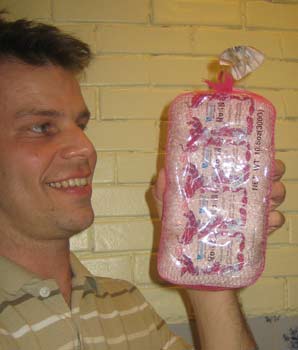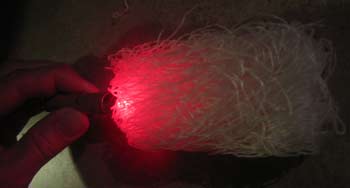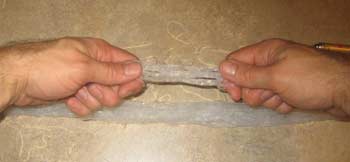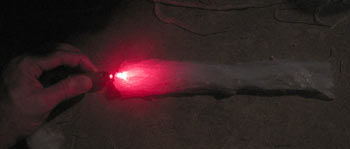

 |
 |
 After my two failed attempts (1 2) at making fiber-optic cable, I got quite a few emails, including some with a great suggestion!
I decided to try their idea: bean vermicelli noodles.
|
|

For sale at Raley's, an eight-pack for $1.19. They are also known as "Rice Noodles" or "Spaghetti 2030".
I had never really contemplated how many different noodles are available for eating. I can't really go into it now, but there are a lot! |
|

The bean vermicelli was obviously a lot more transparent than the spaghetti, but a quick test with a laser wasn't impressive against the crumpled brick of dry noodles. |
|

They needed to be cooked, so I threw a couple of wads into a boiling pot of water. Stacy was already making tea, so the water was ready to go. |
|

After a few minutes, the noodles were finished cooking. They were nearly transparent! They looked great! It is a shame I cannot say the same for Stacy's tea. It had a distinct starchy aftertaste. |
|
|
In the bottom of the colander, the wet noodles were as clear as wet ice. I shot a laser in, and the light spread out into a wide spot. At the time, I figured this was a good thing, but now I'm not so sure. The wet noodles were translucent. I just had to get a bunch out and test their ability to carry a beam of light. |
|

I scooped out fat bundles of snotty noodles and pulled them into a long pile on the counter. |
|

When I had a nice pile stacked up, I gave one end a nice clean-up trim. Oh man, I was very excited to try these out! They looked great, and they were the perfect size and shape! |
|

No! The laser went in strong, but died away less than half of the way in. Damn! As the noodles dried on my counter, they had become more and more opaque, until they were just a bit better than the spaghetti from Sunday night. I yanked this new failure off of the counter and threw it into an adorable paper take-out box. The rice noodles would not work for fiber optics, but at least I had a great material for my holiday faux-icicle decorations! |
|
Other incredible stuff | Home | Contact Rob | fishing line fiberoptics | spaghetti fiber-optics
May 11th, 2006.